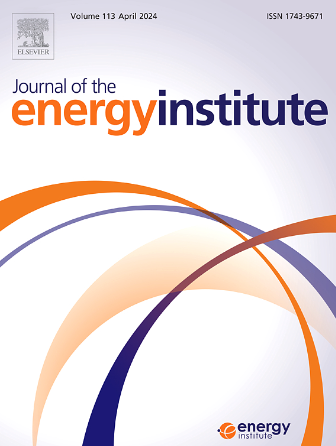甲醇燃料发动机的甲醇和甲醛未受管制排放概况
IF 5.6
2区 工程技术
Q2 ENERGY & FUELS
引用次数: 0
摘要
根据原料的丰富程度,甲醇可分为绿色甲醇、生物质甲醇和化石燃料衍生甲醇。然而,甲醇的使用有利于减少发动机的一氧化碳(CO)、碳氢化合物(HC)和颗粒物(PM)排放,但与传统的汽油或柴油发动机相比,甲醇的非规范排放会增加。未受管制的排放物包括甲醛、乙醛、丙醛、正丁醛、甲醇、丙酮、乙醇等,其中以未燃烧的甲醇和甲醛为主。未燃甲醇主要是由缝隙和淬火效应产生的,甲醛则是由甲醇在排气系统中不完全氧化产生的。废气再循环(EGR)、发动机负荷和转速、进气和排气温度、甲醇替代率(MSR)和喷射策略等因素都会在一定程度上影响未燃甲醇和甲醛的排放。液相色谱法(LC)和气相色谱法(GC)比傅立叶变换红外光谱法(FTIR)能更准确地测量未燃甲醇和甲醛的排放,但傅立叶变换红外光谱法能在不同的运行条件下实时检测未燃甲醇和甲醛的排放数据,或同时在线检测多种排放物。柴油氧化催化剂 (DOC)、颗粒氧化催化剂 (POC) 或三元催化剂 (TWC) 等后处理装置可以减少未燃烧甲醇或甲醛的排放。DOC 和 POC 的组合在去除未燃烧甲醇和甲醛排放方面优于单一 DOC。该综述对甲醇和甲醛的产生、危害、测量和处置进行了系统分析,促进了甲醇燃料的清洁应用。本文章由计算机程序翻译,如有差异,请以英文原文为准。
Overview for methanol and formaldehyde unregulated emissions of methanol fueled engines
Methanol can be classified into green methanol, biomass methanol, and fossil fuel derived methanol based on the abundant feedstocks, and it has been widely applied on road and marine transport vehicles. However, the utilization of methanol is favorable for reducing carbon monoxide (CO), hydrocarbon (HC), and particulate matter (PM) engine emissions, its unregulated emissions increase compared to traditional gasoline or diesel engines. The unregulated emissions include formaldehyde, acetaldehyde, propionaldehyde, n-butyraldehyde, methanol, acetone, ethanol and etc., among which the unburned methanol and formaldehyde are predominant. The unburned methanol is mainly generated by the crevice and quenching effects, and formaldehyde by the incomplete oxidation of methanol in the exhaust system. Factors including exhaust gas recirculation (EGR), engine load and speed, intake and exhaust temperature, methanol substitution rate (MSR), and injection strategy affect the unburned methanol and formaldehyde emissions to a certain extent. Liquid chromatography (LC) and gas chromatography (GC) measure unburned methanol and formaldehyde emissions more accurately than Fourier transform infrared (FTIR), but FTIR can detect data on unburned methanol and formaldehyde emissions in real time under variable operating conditions or online for multiple emissions simultaneously. After-treatment devices such as diesel oxidation catalyst (DOC), particle oxidation catalyst (POC), or three-way catalyst (TWC) can reduce unburned methanol or formaldehyde emissions. The combination of DOC and POC is superior to a single DOC to remove the unburned methanol and formaldehyde emissions. The review provides a systemic analysis on the generation, hazard, measurement, and disposal of methanol and formaldehyde and promotes the clean application of methanol fuel.
求助全文
通过发布文献求助,成功后即可免费获取论文全文。
去求助
来源期刊

Journal of The Energy Institute
工程技术-能源与燃料
CiteScore
10.60
自引率
5.30%
发文量
166
审稿时长
16 days
期刊介绍:
The Journal of the Energy Institute provides peer reviewed coverage of original high quality research on energy, engineering and technology.The coverage is broad and the main areas of interest include:
Combustion engineering and associated technologies; process heating; power generation; engines and propulsion; emissions and environmental pollution control; clean coal technologies; carbon abatement technologies
Emissions and environmental pollution control; safety and hazards;
Clean coal technologies; carbon abatement technologies, including carbon capture and storage, CCS;
Petroleum engineering and fuel quality, including storage and transport
Alternative energy sources; biomass utilisation and biomass conversion technologies; energy from waste, incineration and recycling
Energy conversion, energy recovery and energy efficiency; space heating, fuel cells, heat pumps and cooling systems
Energy storage
The journal''s coverage reflects changes in energy technology that result from the transition to more efficient energy production and end use together with reduced carbon emission.
 求助内容:
求助内容: 应助结果提醒方式:
应助结果提醒方式:


